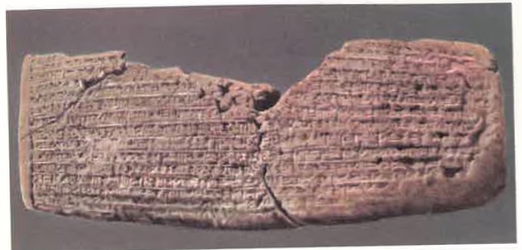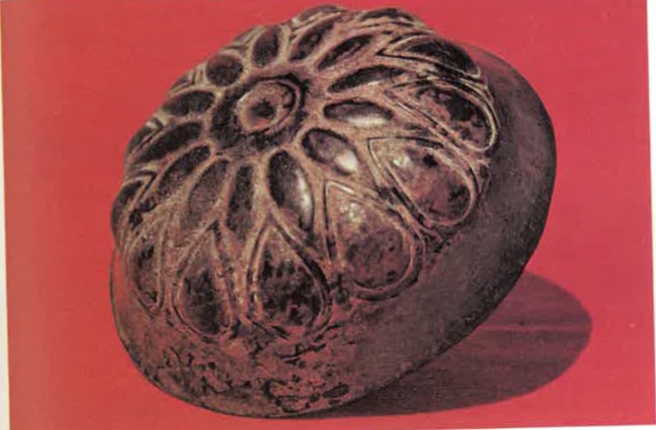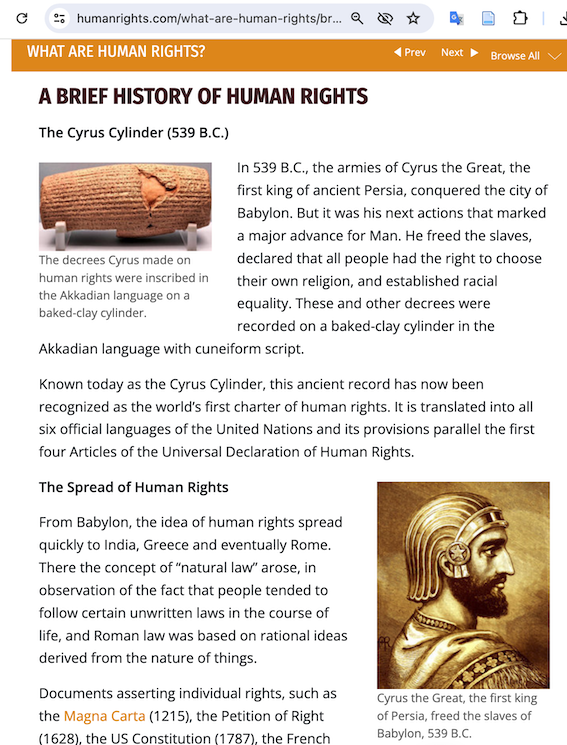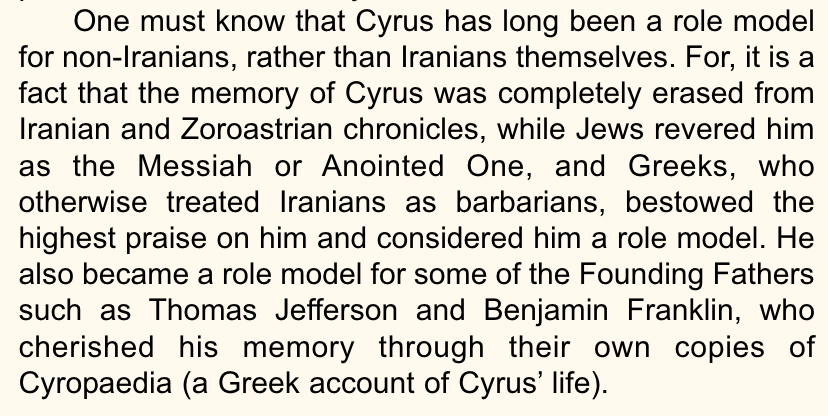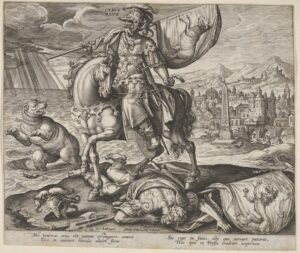
The Cyrus Cylinder is not evidence that the Persian king Cyrus commissioned a return of Judeans to restore their temple (as explained in the previous post) but it does show us why the biblical authors proclaimed Cyrus to be the “anointed one” as their central character in their mythical narrative of that return.
In the book of Isaiah (a work that claims itself to have been written around about 700 BCE) we read that God foretold that 200 years hence he would use a king named Cyrus to restore the Judeans (who since 700 BCE had been taken captive into Babylonia) back to their homeland. The author of the “book of Isaiah” boasted that God knew 200 years in advance that the name of this ordained king would be “Cyrus”.
This is what the Lord says to his anointed,
to Cyrus, whose right hand I take hold of
to subdue nations before him
and to strip kings of their armor,
to open doors before him
so that gates will not be shut:
2 I will go before you
and will level the mountains;
I will break down gates of bronze
and cut through bars of iron.
3 I will give you hidden treasures,
riches stored in secret places,
so that you may know that I am the Lord,
the God of Israel, who summons you by name.
4 For the sake of Jacob my servant,
of Israel my chosen,
I summon you by name
and bestow on you a title of honor,
though you do not acknowledge me. (Isa 45:1-4 NIV)
I suggest that the biblical author was very likely inspired by the propaganda of the priests of the god Marduk. Their god, Marduk, according to what was written in that famous Cylinder, prophesied that a king by the name of Cyrus would arrive as a savior and restorer of his temple cult:
Marduk examined, inspected the totality of all his countries. He looked for a just prince to his heart’s content, who holds his hand (in the new year’s ceremony). Cyrus, king of the city of Anshan, he told his name, he announced his name to rule over the whole universe. He threw the Gute country, the totality of the ummân-manda before his feet. (Harmatta 226)
or in another translation of the cuneiform tablet:
He [Marduk] scanned and looked [through] all the countries, searching for a righteous ruler willing to lead [him] [in the annual procession]. [Then] he pronounced the name of Cyrus, king of Anshan, declared him to be[come] the ruler of all the world … (Wiesehöfer 45)
Was the god Marduk emulating Yahweh in calling Cyrus “by name” for his mission or was it the other way around?
But why was Cyrus the chosen figure in the first place? If the biblical accounts were written in the Hellenistic period — a view that I have been supporting in recent posts — how do we explain their interest in the Persian king Cyrus?
The answer to that question comes from Hellenistic era works themselves. Or at least it comes from Greek works that surely became better known throughout the “Near East” in the wake of Alexander’s conquests.
We have some evidence that there were popular stories told about Mesopotamian kings by word of mouth, folk-tales if you will, throughout the centuries.
That the non-literate public not only told, but also shaped tales about the past is, I think, shown by the curious relationship between the stories of the young Sargon of Akkad and Cyrus the Great. (Drews 388)
The stories, Drews points out, that are told about a much earlier (by centuries) king Sargon of Assyria are almost an exact prefiguring of stories that came to be told about Cyrus —
- Both were abandoned by their parents
- Both were raised by lowly parents and became gardeners
- Both became cupbearers to the king
- Both replaced the king they served
Robert Drews reasons that the fact that the same story can be told about two different figures in different times indicates that the story was passed on by oral tradition. If the details such as the identity of the hero had been a matter exclusively of written record it is hard to understand how such a detail could be changed. Drews further points to “the same story” told by an even earlier Mesopotamian hero, Lugalzagisi. The oral tradents changed the name to suit each new situation.
Let’s come forward to the Hellenistic era, or at least to Greek authors who were already “classics” by the time of Alexander’s conquests.
Xenophon was a Greek commander of mercenaries who had traversed through the Persian empire. In one of his works (written around 370 BCE — circa 160 years after the time of Cyrus) he wrote what was essentially a philosophical treatise on the qualities of an ideal ruler. The person who embodied all of his ideal attributes was Cyrus. Though his account of what became known as “The Education of Cyrus” is more philosophical and idealistic than historical-factual, he did note that
Of Cyrus himself, even now in the songs and stories of the East the record lives that nature made him most fair to look upon, and set in his heart the threefold love of man, of knowledge, and of honour. He would endure all labours, he would undergo all dangers, for the sake of glory. Blest by nature with such gifts of soul and body, his memory lives to this day in the mindful heart of ages. . . . (Xenophon, trans. Dakyns 5)
We can conclude that popular story-telling about Cyrus continued into Greek (Hellenistic) times.
What of the reality, though? What did Cyrus do that might have lent some credence to such stories? After all, after Cyrus defeated the Babylonian army (outside the city of Babylon) at Opis, …..
The Persian victor [i.e. Cyrus] followed up his massacre at Opis by receiving the surrender of Sippar and sending his general Gobryas to invest Babylon, where the defeated Babylonian king, Nabonidus, was taken prisoner. In the calm following battle and defeat, the Babylonian populace received Cyrus formally into the great capital as their new king. Cyrus accepted the surrender, cast himself in the role of divinely blessed ruler of Babylon and expressed it through sanctioning civic and sacred building-works, authorising offerings to the gods and proclaiming formally the restoration of destroyed sanctuaries and the return of their peoples. . . . Such public proclamations were part of the traditional rhetoric of Babylonian conquerors after triumph …: they guaranteed continuity to the defeated and provided a way for the local élite to collaborate with the new rulers ….
Cyrus’ achievements can only be described as spectacular: in less than thirty years, he brought a vast territory under the control of a kingdom which, at the beginning of his reign, had been tiny. He was a brilliant tactician and strategist, able to move rapidly across enormous distances, take his opponents by surprise, and make calculated use of brutal and placatory gestures. The Persians celebrated his fame in song and story . . . . His astonishing success led rapidly to the creation of innumerable popular stories, which obscured his true background: he was presented variously as the grandson of the Median king, Astyages, exposed by his jealous grandfather, brought up by humble herding folk, ultimately identified and eventually returned to his parents (Herodotus 1.107—108), and as the son of poverty stricken parents who worked his way up at the Median court and eventually overthrew the Medes . . . . Other stories abounded, according to Herodotus. They are typical of the tales told about culture-heroes and founders of great empires (e.g. Sargon of Agade … , Moses, Romulus and Remus). (Kuhrt 1995: 659-661)
I have referred to the Greek author Xenophon. Herodotus also related heroic tales of Cyrus — how he was divinely ordained to inherit universal power despite human attempts to thwart his rise. Another Greek author who wrote of Cyrus as a divinely blessed child and triumphant ruler was Ctesias, a Greek physician who tended the Persian royal family in Babylon in the 490s BCE.
It was in the Greek literature that Cyrus stood out as an obvious candidate to fulfil the retrospective role of an ideal ruler chosen by God to fulfill his
The Greek doctor, Ctesias, who worked at the Persian court in the late fifth to early fourth century,2 has Cyrus start life in the lowest stratum of Persian society, working himself up to the position of royal cup bearer, and eventually overthrowing the Median realm . . . .
2 There is now a growing consensus that Ctesias’ account reflects Persian oral traditions….
(Kuhrt 2007: 108)
Returning to the original testimony of Cyrus, moreover, we find another strong act that made him a most likely “saviour” candidate. The Cyrus Cylinder inscription borrows a line from the Babylonian creation epic (Enuma Elish) to present Cyrus as nothing less than a restorer of the intended order of the creation of the universe:
Without battle and fighting he [i.e. Marduk] let him [i.e. Cyrus] enter Babylon. He [i.e. Marduk] saved his city Babylon from its oppression.
. . . [N]obody should doubt that what is being described here is not a national disaster but a process of salvation (et ̧e-ru = ‘to save’). However, there is much more to the passage than meets the eye. As Hanspeter Schaudig has pointed out, we have here a thinly-veiled allusion to a line from tablet vi of Enu-ma eliš, the Babylonian ‘Epic of Creation’, as it is often called. The relevant passage comes near the end of Enu-ma eliš and forms part of the solemn list of Marduk’s names. It sums up the defeat of Tiamat …, the creation of the world … and the building of Babylon …. The Persian takeover, in the allusive words of the Cyrus Cylinder, becomes part of this grand cosmic drama. Far from disrupting the familiar patterns of Babylonian thought and culture, it presents itself as the moment of ultimate restoration, not only of the city’s political and religious institutions, but of the cosmic order more generally.
In the Cyrus Cylinder, then, the Persians cast their conquest of Babylon as the final act in the cosmic drama which, to Babylonian readers, guaranteed the very existence of their universe.24
24 In case it be objected that the Cylinder was a building inscription and cannot therefore have had any real impact on Babylonian audiences, we need to remember that archive copies were kept of important building inscriptions, and that the extant text of the Cyrus Cylinder may have been just such a copy: Schaudig (2001), 46. More generally, Kuhrt and Sherwin-White (1991), 74 emphasize the public nature of major building inscriptions such as the Cyrus Cylinder.
(Haubold 2007: 51f)
In another Babylonian text from the time of ….. Cyrus is said to have followed in the footsteps of Nebuchadnezzar insofar as his piety in restoring Babylon and the cult of its god to the highest prominence. What could a comparison with Nebuchadnezzar mean? Nebuchadnezzar, in Greek culture, was on a par with the god-man hero Heracles. Perhaps not quite as grandiose as a Restorer of the Cosmic Order, but a powerful figure in the minds of Greeks and others nonetheless.
[W]hen Cyrus marched into Babylon, the priests of Marduk declared him a new Nebuchadnezzar in the so-called Persian Verse Account, a pamphlet against Nabonidus. It was not necessary to be of Babylonian descent/come from Babylon in order to impersonate Nebuchadnezzar. It was rather the other way round: Cyrus became legitimately Babylonian by acting like a new Nebuchadnezzar. . . . . (Haubold 2022: 80)
And how did Nebuchadnezzar act — at least according to Hellenistic writers?
Nebuchadnezzar’s importance as a model king would have been evident to any Babylonian readers of Berossus: for them, he was a national hero. It would have been less obvious to Greeks, who could read about him neither in Ctesias nor Herodotus. Things changed under the Seleucids, with Megasthenes comparing Nebuchadnezzar favourably to Heracles.32
32 FGrH 715 F1. Megasthenes’ claim may owe something to traditions about Nebuchadnezzar’s siege of Tyre, imagined as the city of Heracles/Melqart.
(Haubold 2007: 112)
I don’t have the Jacoby fragment cited but there is the following freely available online (Megasthenes was a Hellenistic author around 300 BC):
Abydenus, in his history of the Assyrians, has preserved the following fragment of Megasthenes, who says: That Nabucodrosorus, having become more powerful than Hercules, invaded Libya and Iberia, and when he had rendered them tributary, he extended his conquests over the inhabitants of the shores upon the right of the sea.
Cyrus in the minds of Hellenistic authors and audiences was clearly a prime candidate to be a Messianic figure ordained to restore the Judeans to their “homeland”.
Subsequent Persian kings were only represented decline. Plato’s great myth of Atlantis is widely interpreted as referring to the once-great Persian empire that only declined in its glories and virtues after Cyrus. The Persian monarch Xerxes is even depicted by Herodotus as reviving the ancient Trojan War when he wrote of the king staging a visit to Troy on the eve of his march into Greece:
As has long been recognized, the visit of Xerxes to Troy was a carefully planned piece of propaganda, designed to cast the king as the champion of Troy in the eyes of a Greek audience. . . . But . . . it is not difficult to see that what he heard, or was rumoured to have heard, was an imperial version of the epic past to match the prophecies [that] had ‘shown’ the king how he could conquer Greece. . . . .
. . . the overall message was clear enough: Xerxes had declared himself the avenger of Priam.
the invaders kept alive the idea that their campaign was a continuation of the Trojan War. (Haubold 2007: 55f)
The Trojan War in Greek minds marked the time that separated the present word of mortals from an earlier time when humans and gods directly interacted, even mating and bearing heroic offspring. If Xerxes was threatening to overturn the will of the gods that had long been decreed, Cyrus, the first Persian king, had “saved” a corrupted world and restored the will of the supreme god by fulfilling the edicts of Marduk, the god who had called him “by name” — just as Isaiah declared that Yahweh would do.
One will not be wrong in thinking that the overall tenor of these recent posts is that they suggest a probability that the Bible originated as a work of the Hellenistic era.
Drews, Robert. “Sargon, Cyrus and Mesopotamian Folk History.” Journal of Near Eastern Studies 33, no. 4 (1974): 387–93.
Harmatta, J. “The Literary Patterns of the Babylonian Edict of Cyrus.” Acta Antiqua Academiae Scientiarum Hungaricae 19 (1971): 217–31.
Haubold, Johannes. “Berossus.” In The Romance between Greece and the East, edited by Tim Whitmarsh and Stuart Thomson, 105–16. Cambridge New York: Cambridge University Press, 2013.
Haubold, Johannes. “Memory and Resistance in the Seleucid World: The Case of Babylon.” In Cultures of Resistance in the Hellenistic East, edited by Paul J. Kosmin and Ian S. Moyer, 77–94. Oxford ; New York, NY: Oxford University Press UK, 2022.
Haubold, Johannes. “Xerxes’ Homer.” In Cultural Responses to the Persian Wars: Antiquity to the Third Millennium, edited by Emma Bridges, Edith Hall, and P. J. Rhodes, 47–63. Oxford University Press, 2007.
Kuhrt, Amélie. “Ancient Near Eastern History: The Case of Cyrus the Great of Persia.” In Understanding the History of Ancient Israel, edited by Williamson, Illustrated edition., 107–27. Oxford ; New York: Oxford University Press UK, 2007.
Kuhrt, Amélie. The Ancient near East c. 3000-330 BC: Vol II. London: Routledge, 1995.
Wiesehöfer, Josef. Ancient Persia. 4th edition. London: I.B. Tauris, 2001.
Xenophon. The Education of Cyrus. Translated by Henry Graham Dakyns. London: J.M. Dent, 1914.

